UCOSIII-移植
源码下载
本文参考自正点原子视频以及笔记
在官方下载源码
UCOSIII官网

解压后打开官方基于STM32F107移植好的源码

移植
基础工程
- 创建好准备移植的STM32基础工程

- 在工程“UCOSIII移植”中新建文件夹"UCOSIII"用于存放UCOSIII有关源码 从官方拷贝的文件源码全都放于此文件夹下
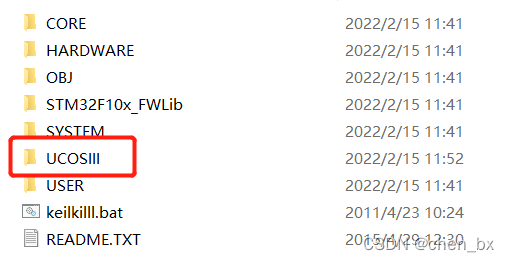
-
将官方移植好的以下三个文件夹路径为
UCOSIII官方STM32F107移植\Micrium\Software复制到我们的工程中UCOSIII目录下路径为UCOSIII移植\UCOSIII

-
工程文件UCOSIII目录下新建UCOS-BSP以及UCOS-CONFIG文件夹

向BSP、CONFIG文件夹添加文件
CONFIG文件夹
将官方移植源码中 路径为UCOSIII官方STM32F107移植\Micrium\Software\EvalBoards\Micrium\uC-Eval-STM32F107\uCOS-III的以下文件拷贝至我们工程UCOSIII目录下UCOS-CONFIG文件夹中路径为UCOSIII移植\UCOSIII\UCOS-CONFIG

UCOS-CONFIG文件夹添加文件后目录如下
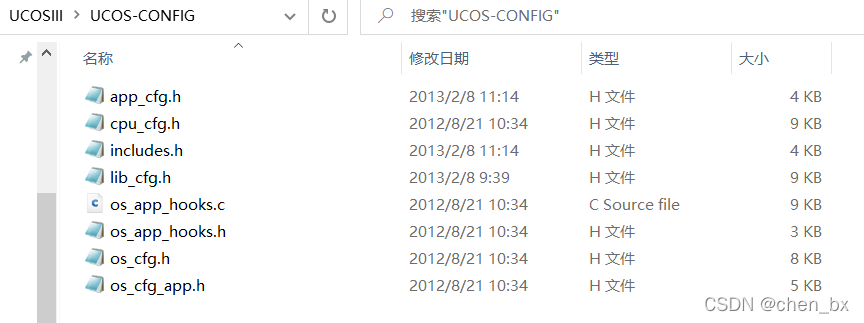
BSP文件夹
将官方移植源码中 路径为UCOSIII官方STM32F107移植\Micrium\Software\EvalBoards\Micrium\uC-Eval-STM32F107\BSP的以下文件拷贝至我们工程UCOSIII目录下UCOS-BSP文件夹中路径为UCOSIII移植\UCOSIII\UCOS-BSP

UCOS-BSP文件夹添加文件后目录如下

工程中添加
- 在keil中添加分组
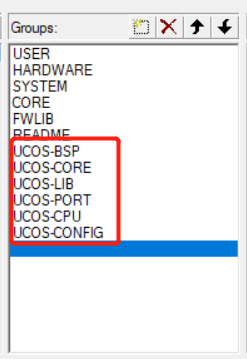
- UCOS-BSP 分组路径为
UCOSIII移植\UCOS-BSP
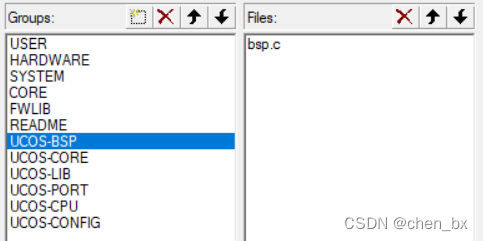
-
UCOS-CPU 分组路径为
UCOSIII移植\UCOSIII\uC-CPU
使用keil cpu_c.c应选择路径为UCOSIII移植\UCOSIII\uC-CPU\ARM-Cortex-M3\RealView中的cpu_c.c

-
UCOS-LIB 分组路径为
UCOSIII移植\UCOSIII\uC-LIB
使用keil lib_mem_a.asm应选择路径为UCOSIII移植\UCOSIII\uC-CPU\ARM-Cortex-M3\RealView中的lib_mem_a.asm

-
UCOS-PORT 分组路径为
UCOSIII移植\UCOSIII\uCOS-III\Ports
使用keil 选择路径UCOSIII移植\UCOSIII\uCOS-III\Ports\ARM-Cortex-M3\Generic\RealView

-
UCOS-CONFIG 分组路径为
UCOSIII移植\UCOSIII\UCOS-CONFIG

-
UCOS-CORE 分组路径为
UCOSIII移植\UCOSIII\uCOS-III\Source
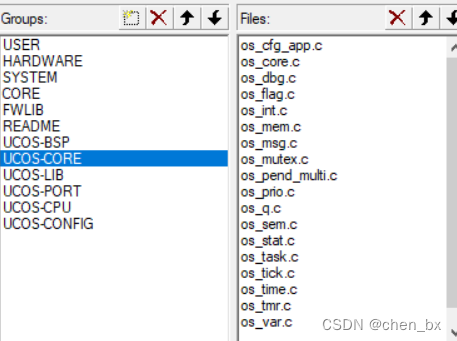
魔术棒添加宏

修改文件权限
工程中文件带锁,只有只读的权限

修改文件权限将UCOSIII文件夹右键属性修改

修改bsp.c 、bsp.h 文件
bsp.c、bsp.h使用的是正点原子移植例程中已经修改好的bsp.c、bsp.h文件 将其替换掉工程中的bsp.c、bsp.h文件

编译后无警告错误,至此移植暂为成功,语法上没有错误

修改os_cpu_a.asm文件
使用的是正点原子移植例程中已经修改好的os_cpu_a.asm文件 代码如下 将其拷贝覆盖os_cpu_a.asm文件
;
;********************************************************************************************************
; uC/OS-III
; The Real-Time Kernel
;
;
; (c) Copyright 2009-2010; Micrium, Inc.; Weston, FL
; All rights reserved. Protected by international copyright laws.
;
; ARM Cortex-M3 Port
;
; File : OS_CPU_A.ASM
; Version : V3.01.2
; By : JJL
; BAN
;
; For : ARMv7M Cortex-M3
; Mode : Thumb2
; Toolchain : RealView Development Suite
; RealView Microcontroller Development Kit (MDK)
; ARM Developer Suite (ADS)
; Keil uVision
;********************************************************************************************************
;
;********************************************************************************************************
; PUBLIC FUNCTIONS
;********************************************************************************************************
IMPORT OSRunning ; External references
IMPORT OSPrioCur
IMPORT OSPrioHighRdy
IMPORT OSTCBCurPtr
IMPORT OSTCBHighRdyPtr
IMPORT OSIntExit
IMPORT OSTaskSwHook
IMPORT OS_CPU_ExceptStkBase
EXPORT OSStartHighRdy ; Functions declared in this file
EXPORT OS_CPU_PendSVHandler
;PAGE
;********************************************************************************************************
; EQUATES
;********************************************************************************************************
NVIC_INT_CTRL EQU 0xE000ED04 ; Interrupt control state register.
NVIC_SYSPRI14 EQU 0xE000ED22 ; System priority register (priority 14).
NVIC_PENDSV_PRI EQU 0xFF ; PendSV priority value (lowest).
NVIC_PENDSVSET EQU 0x10000000 ; Value to trigger PendSV exception.
;********************************************************************************************************
; CODE GENERATION DIRECTIVES
;********************************************************************************************************
PRESERVE8
THUMB
AREA CODE, CODE, READONLY
;PAGE
;********************************************************************************************************
; START MULTITASKING
; void OSStartHighRdy(void)
;
; Note(s) : 1) This function triggers a PendSV exception (essentially, causes a context switch) to cause
; the first task to start.
;
; 2) OSStartHighRdy() MUST:
; a) Setup PendSV exception priority to lowest;
; b) Set initial PSP to 0, to tell context switcher this is first run;
; c) Set the main stack to OS_CPU_ExceptStkBase
; d) Trigger PendSV exception;
; e) Enable interrupts (tasks will run with interrupts enabled).
;********************************************************************************************************
OSStartHighRdy
LDR R0, =NVIC_SYSPRI14 ; Set the PendSV exception priority
LDR R1, =NVIC_PENDSV_PRI
STRB R1, [R0]
MOVS R0, #0 ; Set the PSP to 0 for initial context switch call
MSR PSP, R0
LDR R0, =OS_CPU_ExceptStkBase ; Initialize the MSP to the OS_CPU_ExceptStkBase
LDR R1, [R0]
MSR MSP, R1
LDR R0, =NVIC_INT_CTRL ; Trigger the PendSV exception (causes context switch)
LDR R1, =NVIC_PENDSVSET
STR R1, [R0]
CPSIE I ; Enable interrupts at processor level
OSStartHang
B OSStartHang ; Should never get here
;PAGE
;********************************************************************************************************
; HANDLE PendSV EXCEPTION
; void OS_CPU_PendSVHandler(void)
;
; Note(s) : 1) PendSV is used to cause a context switch. This is a recommended method for performing
; context switches with Cortex-M3. This is because the Cortex-M3 auto-saves half of the
; processor context on any exception, and restores same on return from exception. So only
; saving of R4-R11 is required and fixing up the stack pointers. Using the PendSV exception
; this way means that context saving and restoring is identical whether it is initiated from
; a thread or occurs due to an interrupt or exception.
;
; 2) Pseudo-code is:
; a) Get the process SP, if 0 then skip (goto d) the saving part (first context switch);
; b) Save remaining regs r4-r11 on process stack;
; c) Save the process SP in its TCB, OSTCBCurPtr->OSTCBStkPtr = SP;
; d) Call OSTaskSwHook();
; e) Get current high priority, OSPrioCur = OSPrioHighRdy;
; f) Get current ready thread TCB, OSTCBCurPtr = OSTCBHighRdyPtr;
; g) Get new process SP from TCB, SP = OSTCBHighRdyPtr->OSTCBStkPtr;
; h) Restore R4-R11 from new process stack;
; i) Perform exception return which will restore remaining context.
;
; 3) On entry into PendSV handler:
; a) The following have been saved on the process stack (by processor):
; xPSR, PC, LR, R12, R0-R3
; b) Processor mode is switched to Handler mode (from Thread mode)
; c) Stack is Main stack (switched from Process stack)
; d) OSTCBCurPtr points to the OS_TCB of the task to suspend
; OSTCBHighRdyPtr points to the OS_TCB of the task to resume
;
; 4) Since PendSV is set to lowest priority in the system (by OSStartHighRdy() above), we
; know that it will only be run when no other exception or interrupt is active, and
; therefore safe to assume that context being switched out was using the process stack (PSP).
;********************************************************************************************************
OS_CPU_PendSVHandler
CPSID I ; Prevent interruption during context switch
MRS R0, PSP ; PSP is process stack pointer
CBZ R0, OS_CPU_PendSVHandler_nosave ; Skip register save the first time
SUBS R0, R0, #0x20 ; Save remaining regs r4-11 on process stack
STM R0, {R4-R11}
LDR R1, =OSTCBCurPtr ; OSTCBCurPtr->OSTCBStkPtr = SP;
LDR R1, [R1]
STR R0, [R1] ; R0 is SP of process being switched out
; At this point, entire context of process has been saved
OS_CPU_PendSVHandler_nosave
PUSH {R14} ; Save LR exc_return value
LDR R0, =OSTaskSwHook ; OSTaskSwHook();
BLX R0
POP {R14}
LDR R0, =OSPrioCur ; OSPrioCur = OSPrioHighRdy;
LDR R1, =OSPrioHighRdy
LDRB R2, [R1]
STRB R2, [R0]
LDR R0, =OSTCBCurPtr ; OSTCBCurPtr = OSTCBHighRdyPtr;
LDR R1, =OSTCBHighRdyPtr
LDR R2, [R1]
STR R2, [R0]
LDR R0, [R2] ; R0 is new process SP; SP = OSTCBHighRdyPtr->StkPtr;
LDM R0, {R4-R11} ; Restore r4-11 from new process stack
ADDS R0, R0, #0x20
MSR PSP, R0 ; Load PSP with new process SP
ORR LR, LR, #0x04 ; Ensure exception return uses process stack
CPSIE I
BX LR ; Exception return will restore remaining context
END
修改编译会出现错误

在文件stm32f10x_it.c文件中将PendSV_Handler()函数和SysTick_Handler(void)函数注释
//void PendSV_Handler(void)
//{
//}
//void SysTick_Handler(void)
//{
//}
修改os_cpu_c.c文件
添加 include “includes.h”

编译后

在includes.h中的stm32f10x_lib.h注释掉

修改os_cfg_app.h文件
使用的是正点原子移植例程中已经修改好的os_cfg_app.h文件 代码如下 将其拷贝覆盖os_cfg_app.h文件
/*
************************************************************************************************************************
* uC/OS-III
* The Real-Time Kernel
*
* (c) Copyright 2009-2012; Micrium, Inc.; Weston, FL
* All rights reserved. Protected by international copyright laws.
*
* OS CONFIGURATION (APPLICATION SPECIFICS)
*
* File : OS_CFG_APP.H
* By : JJL
* Version : V3.03.01
*
* LICENSING TERMS:
* ---------------
* uC/OS-III is provided in source form for FREE short-term evaluation, for educational use or
* for peaceful research. If you plan or intend to use uC/OS-III in a commercial application/
* product then, you need to contact Micrium to properly license uC/OS-III for its use in your
* application/product. We provide ALL the source code for your convenience and to help you
* experience uC/OS-III. The fact that the source is provided does NOT mean that you can use
* it commercially without paying a licensing fee.
*
* Knowledge of the source code may NOT be used to develop a similar product.
*
* Please help us continue to provide the embedded community with the finest software available.
* Your honesty is greatly appreciated.
*
* You can contact us at www.micrium.com, or by phone at +1 (954) 217-2036.
************************************************************************************************************************
*/
#ifndef OS_CFG_APP_H
#define OS_CFG_APP_H
/*
************************************************************************************************************************
* CONSTANTS
************************************************************************************************************************
*/
/* --------------------- MISCELLANEOUS ------------------ */
#define OS_CFG_MSG_POOL_SIZE 100u /* Maximum number of messages */
#define OS_CFG_ISR_STK_SIZE 128u /* Stack size of ISR stack (number of CPU_STK elements) */
#define OS_CFG_TASK_STK_LIMIT_PCT_EMPTY 10u /* Stack limit position in percentage to empty */
/* ---------------------- IDLE TASK --------------------- */
#define OS_CFG_IDLE_TASK_STK_SIZE 128u /* Stack size (number of CPU_STK elements) */
/* ------------------ ISR HANDLER TASK ------------------ */
#define OS_CFG_INT_Q_SIZE 10u /* Size of ISR handler task queue */
#define OS_CFG_INT_Q_TASK_STK_SIZE 128u /* Stack size (number of CPU_STK elements) */
/* ------------------- STATISTIC TASK ------------------- */
#define OS_CFG_STAT_TASK_PRIO (OS_CFG_PRIO_MAX-2u) /* Priority 统计任务优先级 */
#define OS_CFG_STAT_TASK_RATE_HZ 10u /* Rate of execution (1 to 10 Hz) */
#define OS_CFG_STAT_TASK_STK_SIZE 128u /* Stack size (number of CPU_STK elements) */
/* ------------------------ TICKS ----------------------- */
#define OS_CFG_TICK_RATE_HZ 200u /* Tick rate in Hertz (10 to 1000 Hz) */
#define OS_CFG_TICK_TASK_PRIO 1u /* Priority 时钟节拍任务,一般设置一个相对较高的优先级 */
#define OS_CFG_TICK_TASK_STK_SIZE 128u /* Stack size (number of CPU_STK elements) */
#define OS_CFG_TICK_WHEEL_SIZE 17u /* Number of 'spokes' in tick wheel; SHOULD be prime */
/* ----------------------- TIMERS ----------------------- */
#define OS_CFG_TMR_TASK_PRIO 2u /* Priority of 'Timer Task' 定时任务优先级 */
#define OS_CFG_TMR_TASK_RATE_HZ 100u /* Rate for timers (100 Hz Typ.) */
#define OS_CFG_TMR_TASK_STK_SIZE 128u /* Stack size (number of CPU_STK elements) */
#define OS_CFG_TMR_WHEEL_SIZE 17u /* Number of 'spokes' in timer wheel; SHOULD be prime */
#endif
修改sys.h文件
将 SYSTEM_SUPPORT_OS宏定义设置为1

测试
使用正点原子main函数进行测试

#include "led.h"
#include "delay.h"
#include "sys.h"
#include "usart.h"
#include "includes.h"
//任务优先级
#define START_TASK_PRIO 3
//任务堆栈大小
#define START_STK_SIZE 512
//任务控制块
OS_TCB StartTaskTCB;
//任务堆栈
CPU_STK START_TASK_STK[START_STK_SIZE];
//任务函数
void start_task(void *p_arg);
//任务优先级
#define LED0_TASK_PRIO 4
//任务堆栈大小
#define LED0_STK_SIZE 128
//任务控制块
OS_TCB Led0TaskTCB;
//任务堆栈
CPU_STK LED0_TASK_STK[LED0_STK_SIZE];
void led0_task(void *p_arg);
//任务优先级
#define LED1_TASK_PRIO 5
//任务堆栈大小
#define LED1_STK_SIZE 128
//任务控制块
OS_TCB Led1TaskTCB;
//任务堆栈
CPU_STK LED1_TASK_STK[LED1_STK_SIZE];
//任务函数
void led1_task(void *p_arg);
//任务优先级
#define FLOAT_TASK_PRIO 6
//任务堆栈大小
#define FLOAT_STK_SIZE 128
//任务控制块
OS_TCB FloatTaskTCB;
//任务堆栈
__align(8) CPU_STK FLOAT_TASK_STK[FLOAT_STK_SIZE];
//任务函数
void float_task(void *p_arg);
int main(void)
{
OS_ERR err;
CPU_SR_ALLOC();
delay_init(); //延时初始化
NVIC_PriorityGroupConfig(NVIC_PriorityGroup_2); //中断分组配置
uart_init(115200); //串口波特率设置
LED_Init(); //LED初始化
OSInit(&err); //初始化UCOSIII
OS_CRITICAL_ENTER();//进入临界区
//创建开始任务
OSTaskCreate((OS_TCB * )&StartTaskTCB, //任务控制块
(CPU_CHAR * )"start task", //任务名字
(OS_TASK_PTR )start_task, //任务函数
(void * )0, //传递给任务函数的参数
(OS_PRIO )START_TASK_PRIO, //任务优先级
(CPU_STK * )&START_TASK_STK[0], //任务堆栈基地址
(CPU_STK_SIZE)START_STK_SIZE/10, //任务堆栈深度限位
(CPU_STK_SIZE)START_STK_SIZE, //任务堆栈大小
(OS_MSG_QTY )0, //任务内部消息队列能够接收的最大消息数目,为0时禁止接收消息
(OS_TICK )0, //当使能时间片轮转时的时间片长度,为0时为默认长度,
(void * )0, //用户补充的存储区
(OS_OPT )OS_OPT_TASK_STK_CHK|OS_OPT_TASK_STK_CLR, //任务选项
(OS_ERR * )&err); //存放该函数错误时的返回值
OS_CRITICAL_EXIT(); //退出临界区
OSStart(&err); //开启UCOSIII
while(1);
}
//开始任务函数
void start_task(void *p_arg)
{
OS_ERR err;
CPU_SR_ALLOC();
p_arg = p_arg;
CPU_Init();
#if OS_CFG_STAT_TASK_EN > 0u
OSStatTaskCPUUsageInit(&err); //统计任务
#endif
#ifdef CPU_CFG_INT_DIS_MEAS_EN //如果使能了测量中断关闭时间
CPU_IntDisMeasMaxCurReset();
#endif
#if OS_CFG_SCHED_ROUND_ROBIN_EN //当使用时间片轮转的时候
//使能时间片轮转调度功能,时间片长度为1个系统时钟节拍,既1*5=5ms
OSSchedRoundRobinCfg(DEF_ENABLED,1,&err);
#endif
OS_CRITICAL_ENTER(); //进入临界区
//创建LED0任务
OSTaskCreate((OS_TCB * )&Led0TaskTCB,
(CPU_CHAR * )"led0 task",
(OS_TASK_PTR )led0_task,
(void * )0,
(OS_PRIO )LED0_TASK_PRIO,
(CPU_STK * )&LED0_TASK_STK[0],
(CPU_STK_SIZE)LED0_STK_SIZE/10,
(CPU_STK_SIZE)LED0_STK_SIZE,
(OS_MSG_QTY )0,
(OS_TICK )0,
(void * )0,
(OS_OPT )OS_OPT_TASK_STK_CHK|OS_OPT_TASK_STK_CLR,
(OS_ERR * )&err);
//创建LED1任务
OSTaskCreate((OS_TCB * )&Led1TaskTCB,
(CPU_CHAR * )"led1 task",
(OS_TASK_PTR )led1_task,
(void * )0,
(OS_PRIO )LED1_TASK_PRIO,
(CPU_STK * )&LED1_TASK_STK[0],
(CPU_STK_SIZE)LED1_STK_SIZE/10,
(CPU_STK_SIZE)LED1_STK_SIZE,
(OS_MSG_QTY )0,
(OS_TICK )0,
(void * )0,
(OS_OPT )OS_OPT_TASK_STK_CHK|OS_OPT_TASK_STK_CLR,
(OS_ERR * )&err);
//创建浮点测试任务
OSTaskCreate((OS_TCB * )&FloatTaskTCB,
(CPU_CHAR * )"float test task",
(OS_TASK_PTR )float_task,
(void * )0,
(OS_PRIO )FLOAT_TASK_PRIO,
(CPU_STK * )&FLOAT_TASK_STK[0],
(CPU_STK_SIZE)FLOAT_STK_SIZE/10,
(CPU_STK_SIZE)FLOAT_STK_SIZE,
(OS_MSG_QTY )0,
(OS_TICK )0,
(void * )0,
(OS_OPT )OS_OPT_TASK_STK_CHK|OS_OPT_TASK_STK_CLR,
(OS_ERR * )&err);
OS_TaskSuspend((OS_TCB*)&StartTaskTCB,&err); //挂起开始任务
OS_CRITICAL_EXIT(); //进入临界区
}
//led0任务函数
void led0_task(void *p_arg)
{
OS_ERR err;
p_arg = p_arg;
while(1)
{
LED0=0;
OSTimeDlyHMSM(0,0,0,200,OS_OPT_TIME_HMSM_STRICT,&err); //延时200ms
LED0=1;
OSTimeDlyHMSM(0,0,0,500,OS_OPT_TIME_HMSM_STRICT,&err); //延时500ms
}
}
//led1任务函数
void led1_task(void *p_arg)
{
OS_ERR err;
p_arg = p_arg;
while(1)
{
LED1=~LED1;
OSTimeDlyHMSM(0,0,0,500,OS_OPT_TIME_HMSM_STRICT,&err); //延时500ms
}
}
//浮点测试任务
void float_task(void *p_arg)
{
CPU_SR_ALLOC();
static float float_num=0.01;
while(1)
{
float_num+=0.01f;
OS_CRITICAL_ENTER(); //进入临界区
printf("float_num的值为: %.4f\r\n",float_num);
OS_CRITICAL_EXIT(); //退出临界区
delay_ms(500); //延时500ms
}
}
运行结果
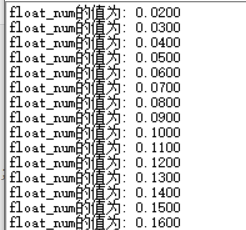
绿灯红灯交替闪烁
证明UCOSIII移植成功,可在工程中编写添加自己的代码